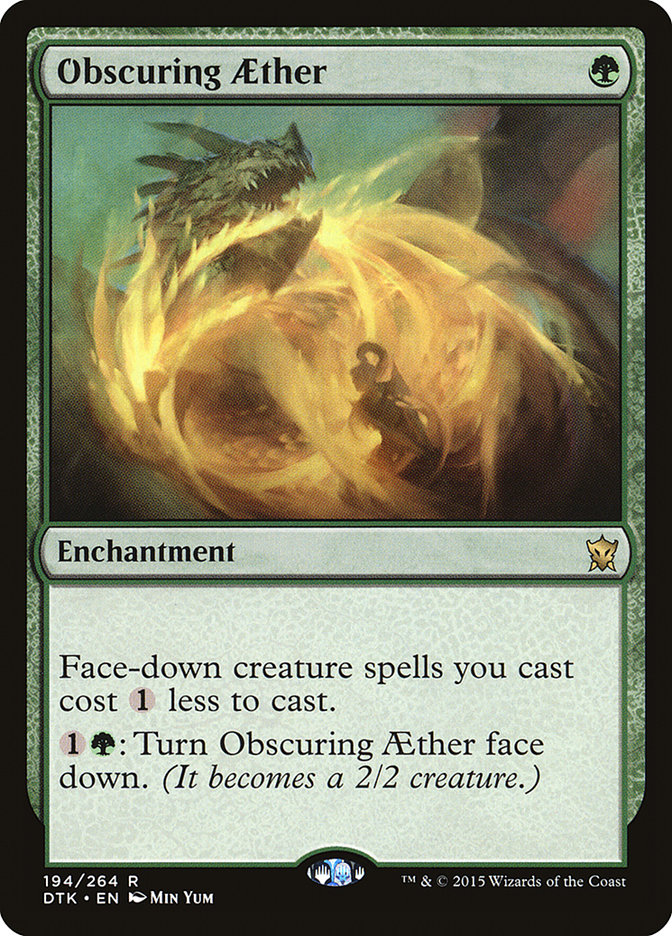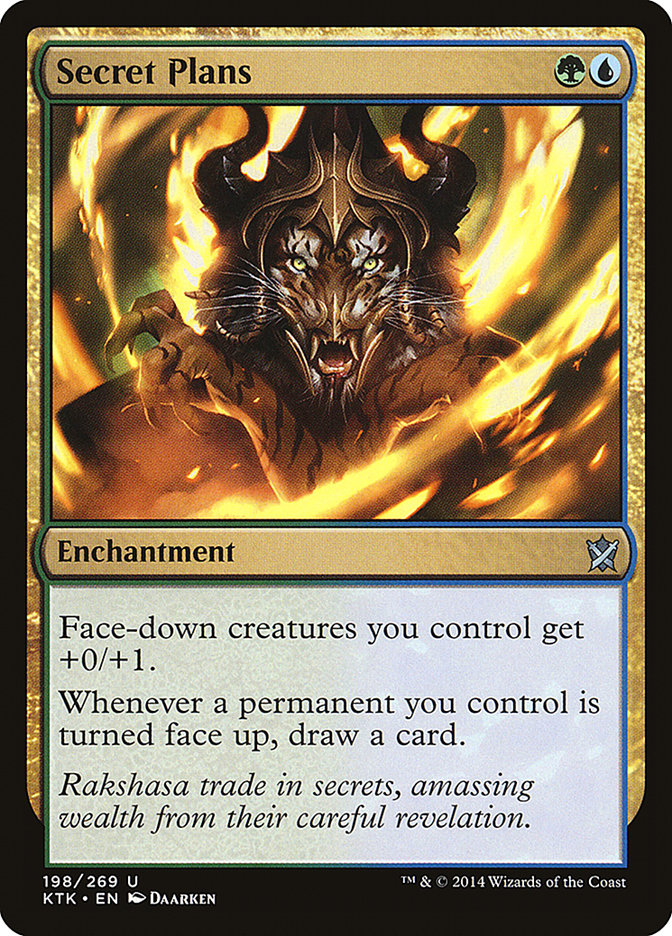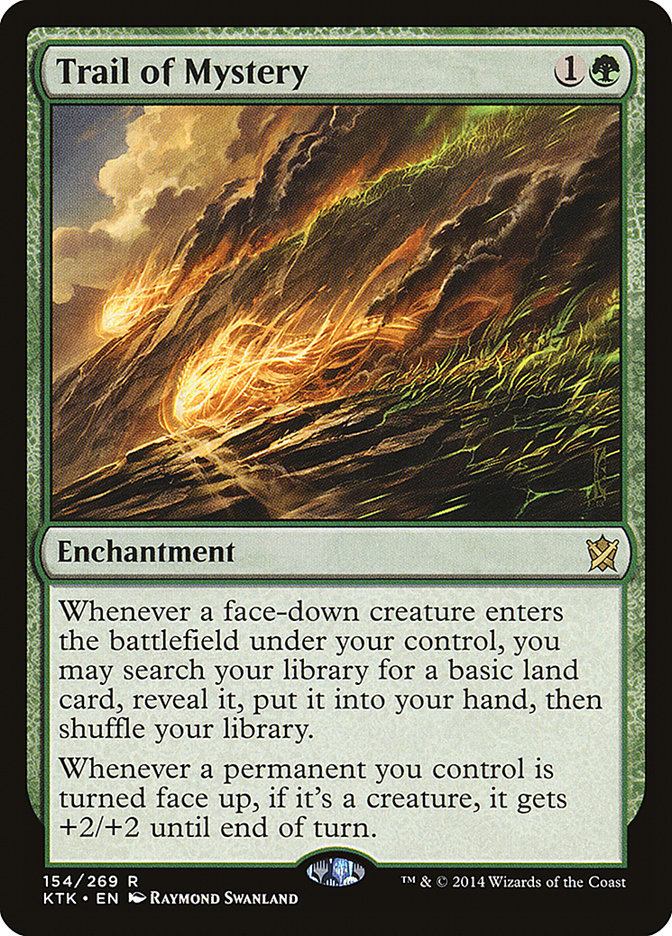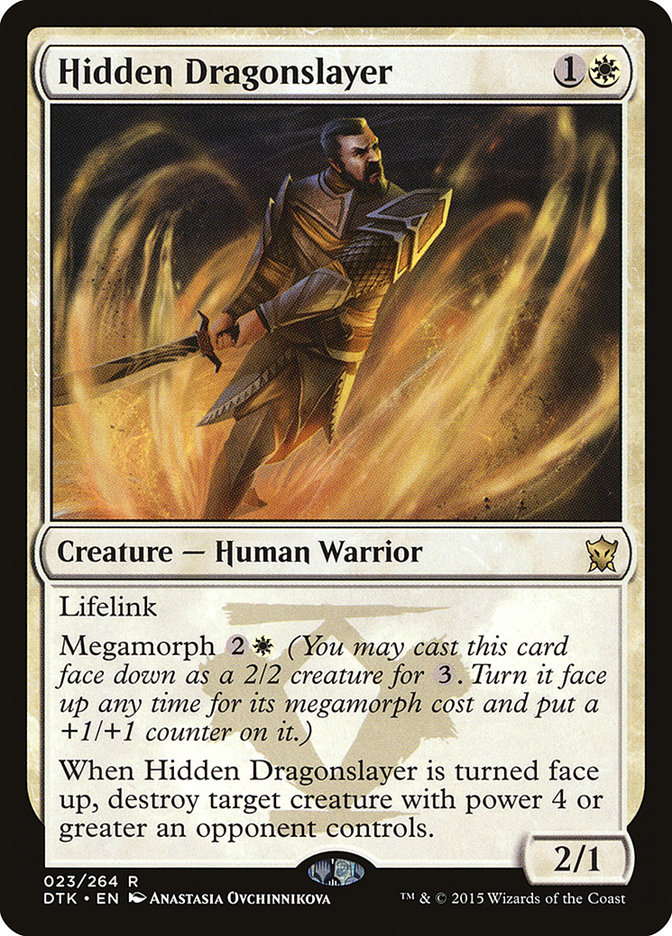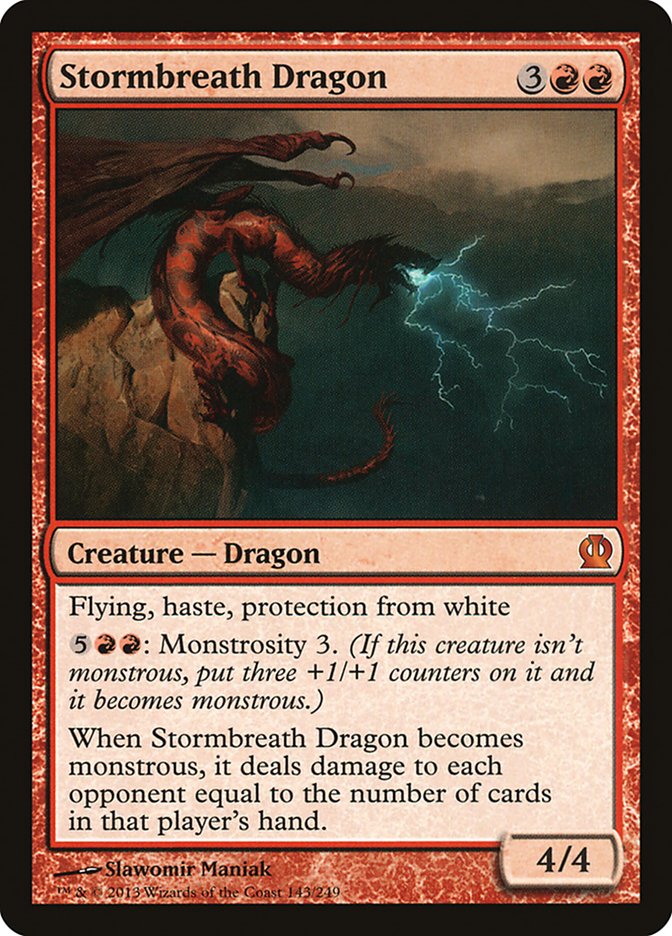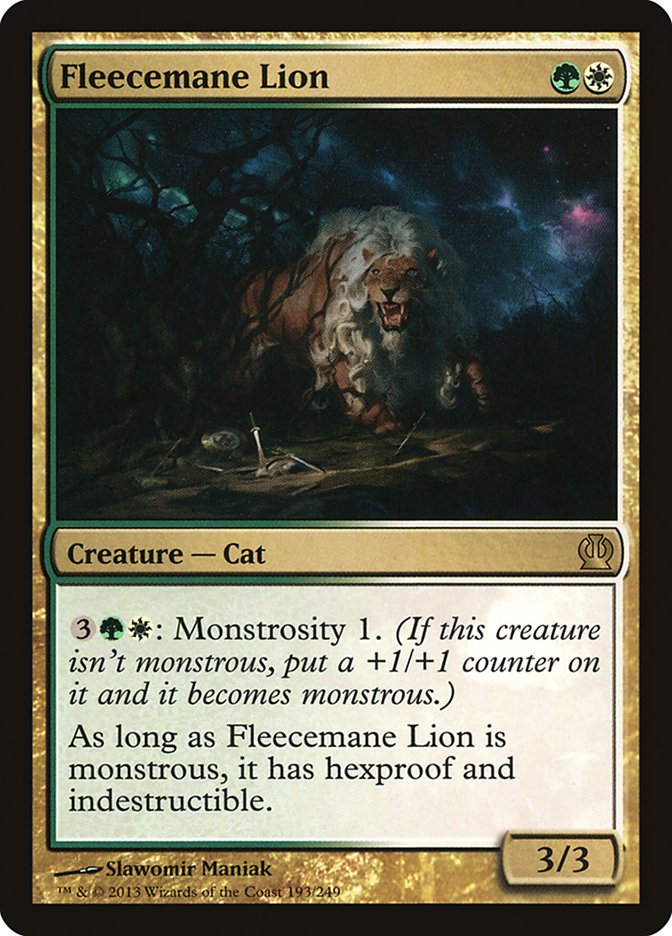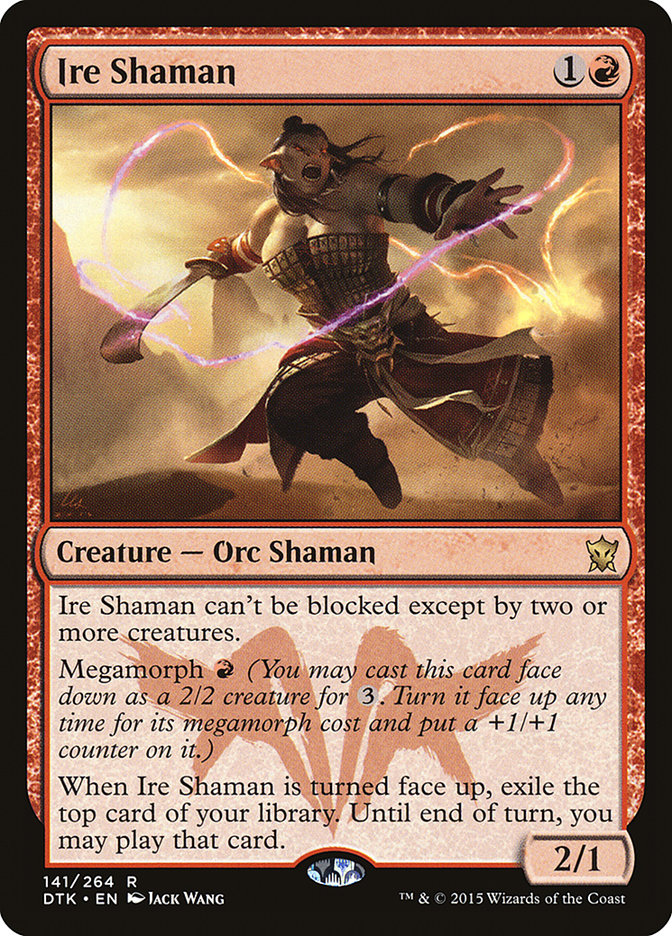30 Dragons in the top 8?
Yeah, I’d have to say “Dragons of Tarkir” is pretty accurately named.
…
This past weekend, I had the privilege of competing in Pro Tour Dragons of Tarkir in Brussels, Belgium. It was particularly fun preparing for it, as
Dragons of Tarkir is one of the deepest and strongest sets in some time. In all, an unheard of 54 new Dragons of Tarkir cards appeared in Pro Tour decks
with a 6-4 Standard record or better. Average would be something in the thirties.
I went to Belgium two weeks early to prepare with the rest of The Pantheon. We rented a former monastery that was actually formerly an iron forge before
that. It was something like a 100 kilometers out in the Belgian countryside, generally pretty far removed from any potential distractions, for better or
for worse.
People in the house were pretty well split up among the major archetypes, so I decided to start by trying a number of radical concepts. I worked on Blue
Devotion, Black Devotion, Hardened Scales, Descent of the Dragons, and more before finally throwing together a G/U Morph deck.
My first draft was shockingly promising but included some failed experiments, like Ghostfire Blade. It turned out a small but slightly efficient piece of
equipment wasn’t what the deck was missing.
The cards that were really impressing were Secret Plans, Obscuring Aether, Deathmist Raptor, and Den Protector. After removing some of the sub-optimal
choices, I arrived at the following list:
Creatures (28)
- 4 Elvish Mystic
- 4 Rattleclaw Mystic
- 4 Icefeather Aven
- 2 Sagu Mauler
- 4 Stratus Dancer
- 4 Den Protector
- 4 Deathmist Raptor
- 2 Ainok Survivalist
Lands (8)
Spells (24)

The deck is not a super rush deck or anything, however. It’s actually just an extremely resilient tempo deck that starts to generate lots of card advantage
from its many two-for-ones and its card advantage engines, Secret Plans and Trail of Mystery. Many of its two-for-ones build on each other, as you end up
making plays like Den Protector on your Icefeather Aven, which then bounces the Den Protector, and so on.
The morph deck can also be a master of building tempo. Over the course of the game, its morphs start to get cheaper and cheaper (sometimes free). It gets
free +2/+2 bounces when creatures flip. It often gets to counter spells, bounce creatures, or destroy artifacts and enchantments for just two mana and zero
extra cards. It also keeps getting Deathmist Raptors back for zero mana.
The ability to play Elvish Mystic or Obscuring Aether on turn 1 meant we were generally going to come out of the game pretty hard.
Obscuring Aether lets us start playing morphs on turn 2, but it starts getting really crazy if we’re drawing extra cards with Secret Plans, often producing
an “effective” three mana a turn.
If you draw Obscuring Aether and Elvish Mystic, it is generally better to play the Mystic first. You can then play the Aether on turn 2 and still play a
morph that turn. Likewise, if you have a Temple of Mystery, a Forest, a Secret Plans, and an Obscuring Aether, playing the Temple of Mystery on turn 1 and
the Secret Plans on turn 2, still leads into a turn 3 Aether and morph (assuming you find a third land by then).
While Obscuring Aether is primarily about the acceleration, it’s also a potent threat that has a lot of implied value on the table. If your opponent sweeps
the board with a timely End Hostilities, you can keep the beats going by flipping your Obscuring Aethers and attacking with them that turn (since they are
still the same card that isn’t summoning sick). You have to pick your spots to do this since you lose the acceleration and can’t flip them back over, but
this is a powerful threat to be capable of at any time.
While you aren’t drawing any cards from Secret Plans because of flipped Aethers, the Plans does make the Aether a 2/3 rather than a 2/2.
Secret Plans is the morph deck’s Bitterblossom. It’s the engine that makes this strategy actually a real thing.
A real thing?
Oh yeah, did I mention? This was the strategy I spent the most time on and that I almost played at the PT. It’s actually good. However, in the end, I
didn’t find the right version (yet), and I am not interested in playing the deck I think had the second best chances of winning it all for me. As a result,
I played soulless and boring Abzan Midrange.
However, back to Secret Plans. You see, Secret Plans is sort of a Glimpse of Nature from now on. You do have to actually unmorph the creatures, so there is
a limit, but when you start factoring in Obscuring Aethers, things actually do get pretty out of control sometimes. Every once in a while, I’d start my
sixth turn with zero or one card, then draw fifteen that turn!
Once you get a second Obscuring Aether online, you are capable of doing so much all of the time and a lot of fundamental costs start breaking down. For
instance, Rattleclaw Mystic is actually free the turn you cast it since it’s unmorph ability generates a mana. If you have some Secret Plans out, you are
casting creatures and drawing cards for zero mana. If you happen to get a third Aether? Well, now you are actually netting mana!
Trail of Mystery is nowhere close to as good or important as Secret Plans, but it is still decent. I only play two, however, as it has really diminishing
returns on the second copy you draw since you end up with more basics in hand than you can ever play.
The threat of +2/+2 pumps is nice, although often you want to flip your morphs outside of combat, creatures like Stratus Dancer and Rattleclaw Mystic. That
said, the big stat boosts work particularly well with all of the evasion, especially Den Protector, who becomes a 5/4 that is 98% unblockable and the
perfect size for killing Elspeth.
From early on, it was clear that the morph deck was very effective against Abzan Midrange and Control, and the Jeskai matchups seemed good (though almost
everyone’s Jeskai matchup seemed good). Decks that relied on creature removal were just not equipped to deal with the speed and resiliency of the morph
deck.
The trouble came from fast and deadly creatures. Red aggro was a challenge, as was G/R Dragons, and even Abzan Aggro, which seemed relatively close, had
some annoying cards like Anafenza, the Foremost, which shut down Deathmist Raptor and made Den Protector a lot worse.
I decided to experiment with a white splash for Hidden Dragonslayer:
Creatures (27)
- 4 Elvish Mystic
- 4 Rattleclaw Mystic
- 1 Icefeather Aven
- 4 Stratus Dancer
- 4 Hidden Dragonslayer
- 4 Den Protector
- 4 Deathmist Raptor
- 2 Ainok Survivalist
Lands (14)
Spells (19)

The Hidden Dragonslayers immediately started impressing me, both for their morph trigger and their body.
The ability to shoot down Siege Rhino, Tasigur, Anafenza, Surrak, Thunderbreak Regent, Polukranos, Whisperwood Elemental, and even Goblin Rabblemaster and
Ojutai was big. The deck already had a lot of tools for interacting with non-creature cards, so having creature-killing capabilities was a much appreciated
new dimension.
Of course, the Dragonslayer was not without a few blindspots:
Hidden Dragonslayer’s lifelink was also a big addition to the deck, particularly when it would get a +2/+2 Trail of Mystery bonus to take down a Siege
Rhino. The morph strategy is very tempo-oriented, and knowing when to switch into “Faeries mode” and just try to race someone is an important part of
piloting it. A little extra life can go a long way towards winning those races.
The white removal spells in the sideboard are nice, but I never quite got the mix I was looking for. Trying to find the right balance against Abzan Aggro,
G/R Dragons, and G/W Devotion is a tricky business. It’s particularly unfortunate that none of the options we actually want beats Stormbreath Dragon, which
is a very challenging card for us (being hard to block and hard to race). Encase in Ice is tempting, but they are bringing in all of the Destructive
Revelry type cards they can, and sometimes even Back to Nature, so I hate to rely on that type of effect in a deck like this.
The best answer I found to Stormbreath Dragon was Arbor Colossus. It’s too big to get Roasted or Dragonlord Atarka’d, which is a big deal. I also
considered options like Plummet and Monastery Flock, but I felt they were probably too narrow.
While the white removal helps with big creatures, it didn’t do much for the red aggro matchup. Fortunately, we already have access to Hornet Nest. An early
Hornet Nest is a fantastic way of buying some time against a hyper-aggressive red aggro swarm. It’s not going to win it for you every time, but it is the
highest impact card you can bring in against them. Goblin Heelcutter can get around it, but it’s hard for people to have too many of that one.
There isn’t a ton of white mana in the above list, but you can play the Hidden Dragonslayers facedown even without it, so it’s less vital. Besides, Trail
of Mystery is also a great way to fix your mana. That said, a red splash is much easier since Rattleclaw Mystic gives it to you for free.
Creatures (28)
- 4 Elvish Mystic
- 4 Rattleclaw Mystic
- 1 Icefeather Aven
- 1 Sagu Mauler
- 4 Stratus Dancer
- 4 Den Protector
- 4 Deathmist Raptor
- 4 Ire Shaman
- 2 Ainok Survivalist
Lands (13)
Spells (19)

The red splash gives us Ire Shaman, a strong card in its own right, which fits into our strategy in a number of ways.
Ire Shaman’s card draw ability can help fuel our engine, but I worry that it is just more power where we don’t need it. The extra card is great against
control and Abzan, but it doesn’t exactly shore up any weaknesses. Likewise, the evasion fits into our general theme, but it’s not exactly a new dimension
the way Hidden Dragonslayer’s lifelink is.
The red removal helps fill out the sideboard as well, but I think the white removal is slightly better, mana considerations aside. The combination of
Rattleclaw Mystic and Frontier Bivouac are appealing enough though, I am going to continue to explore red versions as well as white versions.
I guess we can also look at a black splash, but I am not optimistic. Grim Haruspex is something, and Murderous Cut is awesome, but the mana is actually
worse than the white or red splash. Still, it’s possible that black removal is enough of what we want that we might decide it’s worth it.
In the end, white morphs looked promising, I just ran out of time to get it good enough to be the deck to play, at least in my judgment. Instead, I went
with old faithful, Abzan Midrange. Owen Turtenwald and Jacob Wilson had been tuning a list all week, and William Jensen had also resigned himself to
playing it. Here’s the 75 we registered:
Creatures (13)
Planeswalkers (3)
Lands (21)
Spells (23)

With just Ultimate Price maindeck and Duress sideboard, there isn’t much Dragons of Tarkir to discuss here. Going into the event, I was a little concerned
about the manabase, thinking I might prefer a 26th land. I was considering moving a Read the Bones or Utter End to the sideboard, perhaps cutting the
Ajani, Mentor of Heroes.
In the end, I was fairly happy with the build. I think we could have stood to focus more testing on U/B Control, but who couldn’t? It was definitely a
surprise that that control dominated at the level it did. U/B and Esper Control was by far the best performing macro-archetype, with over 90% of its pilots
making day 2 (compare to an average of 62%). It also had the most great records, including over 30% of its pilots going 7-3 or better in Standard (more
than double the average), and over 20% of its pilots going 8-2 or better (nearly quadruple the average).
Abzan performed above average, though, and I thought we had a well-tuned list. In giving my report to Owen, I noted that Utter End had been good for me,
and I had been drawing enough land, for the most part.
And the Ajani?
Ha!
Well, the Ajani hadn’t been the best for me, but it was hardly Ajani’s fault. After starting out 5-0 and taking over the final game of round 6, I was in a
long and drawn out mirror match and attempting to play extremely fast, trying to finish the round in time. I was ticking up Ugin, Elspeth, and Ajani, but
my opponent was trying to hold out for as long as he could to see if he could live until the end of extra turns.
He removed my Elspeth during his first extra turn, but I still had Ugin and Ajani, and a Read the Bones and Abzan Charm in my hand that I wasn’t playing,
to stay out of Siege Rhino range if possible. I ticked up my Ajani and set my hand down on the table while I picked up the top four cards and held them up.
I’ve been in a lot of feature matches over the years, and it’s very common for coverage people to want to look over your shoulder and ask you to show them
what cards you’ve drawn.
As a result, I’ve gotten used to generally holding up my hand in manner clearly visible to those behind me (and in this case, to the camera). This
generally helps me avoid disruptive interference. Sometimes I think a lot of people underestimate how much their body language reveals about the cards they
are seeing, even when they aren’t playing the game.
After lifting up my four cards and finding only Tasigur, I selected him and set him down on the table, touching my hand, while I resolved the rest of the
Ajani ability, putting the other three cards on the bottom of my deck. When I went back to pick up my hand, the failure to reveal was raised. I immediately
did, as it was still the top card. The judge said it was too late, it had merged with my hand.
I revealed the other two cards and pointed out that the cards had not changed order, but regardless, the judge ruled that because I had not revealed the
Tasigur before it touched another card in my hand, I was getting a penalty and because I “had to reveal private information to prove the card was Tasigur,”
the penalty was being upgraded to a game loss.
Here’s a question for you:
Have you ever seen someone take a mulligan, counting out how many cards from the top of their library they are going to draw? They reflexively lay out a
seventh card and then remember they are taking a mulligan, putting it back…
After it had touched their hand.
Let’s say you start your turn with no cards. You draw a card for your turn, but your opponent motions in a way that you suspect means they want priority
during your upkeep, so you put the card back, but it turns out they don’t.
When you had drawn the card, it was your hand, and now it’s touching the top card of your deck.
These examples seem obvious and easily resolved, but so was this situation. The physical location of the card was not in question. The identity of the card
was not in question. The event that had just transpired was not in question. My intent was not in question. The explanation of the ruling was that the
facts of the case don’t matter once it has been determined that the card physically touched any of the cards in my hand.
Of course, the above examples and numerous others reveal there are exceptions. For instance, the penalty guidelines explicitly state that if the contents
of your hand are known because of Courser of Kruphix, the penalty should not be upgraded. Clearly, judgment is needed. The floor rules are not as crystal
clear on this as might appear on the surface.
Some relevant portions of the Game Rules Violation section of the Floor Rules:
-An error that an opponent has no opportunity to verify the legality of should have its penalty upgraded. These errors involve misplaying hidden
information, such as the morph ability or failing to reveal a card to prove that a choice made was a legal one.
This is the section that speaks to why I would have been issued a game rules violation and had it upgraded to a game loss. Note, this is a very different
situation than intentionally violating game rules, which in this case, would be Cheating – Fraud and result in disqualification from the event.
-If the information was ever in a position where opponents had the opportunity to verify the legality (such as on top of the library, as the only card in
hand, or on the battlefield at the end of the game), do not upgrade the penalty and reveal the information if possible.
This is an important point, because the point of the rule is not to create as many game losses as possible, but to minimize the possibility of abuse. In my
match, my opponent wrongfully believed that none of my hand was public information, and it was his statement as such that lead to my penalty being upgraded
to a game loss. As it turns out, the Abzan Charm had been revealed, however, the Read the Bones had not been revealed by Courser, so there was still basis
for upgrading the penalty if the legality could not be verified.
Recently, some have suggested that it doesn’t matter if the cards were revealed by Courser, but this is not true. As mentioned above, Courser of Kruphix
itself is named in the penalty guidelines as a reason to not upgrade the penalty. The important thing is whether or not the legality of the play can be
verified.
-Additionally, if the card that was supposed to be revealed was put into an empty hand, we also will not upgrade that. This is because there is no
question, no ambiguity what the physical card is.
This is the crucial point of this situation. This is not a “Our hands are tied, there must be zero tolerance for mistake, a game loss is the only way to
preserve the integrity of the event” type of situation. An important part of the philosophy here is to avoid being disruptive as much as possible. When
there is no question, no ambiguity what the physical card is, do not upgrade the penalty, because this section is not designed to “punish” players for
sloppy play, but rather to prevent potential for abuse.
That there was no ambiguity what the physical card was was the crux of my argument and a fact that was agreed on (and could have been verified by countless
witnesses), as the cards had not changed order. The counterargument was that while this fact was agreed on, we also agreed that the card had touched other
cards in my hand. I certainly do not fault the judges for choosing to prioritize that element of the case over the previous, however, I believe that is the
more disruptive path and in the future, we should do the reverse.
-Please note, this is NOT an exhaustive list of exceptions, just the most common ones. Use the guideline of “ever in a position where opponents had the
opportunity to verify the legality” and you should be able to apply this exception correctly.
This speaks to the reason I asked the head judge to use discretion in this case, as this is very much a situation that has countless potential exceptions,
many of which have never been imagined yet. In this case, we had the ability to verify the legality, as the location of the card was not physically
ambiguous. In fact, I immediately did just that, revealing the card.
The head judge does have the ability to determine when an exception is called for, and I believe that such a situation in the future should warrant one,
when the location of the card is agreed upon to be not physically ambiguous, as that is a much more relevant fact of the case than whether or not two cards
touched, for the purposes of minimizing abuse and preserving integrity of a match.
-If the infraction falls into one of the following categories, perform the fix specified unless backing up is very simple: So right here we are going to
have a list of partial fixes. You do them first. If you can’t, then you evaluate if you need to do a back up or leave alone. However, if the backup is
trivially simple, (ex. a single action) and makes for a more organic fix, the HJ may authorize the back up.
Because nothing has happened yet, including changing the order of any cards, it is trivially easy to back up the game and reveal the card and then add it
to the hand. Failure to reveal is not always a backup type of situation, however, when you Mystical Tutor for a card and fail to reveal it before putting
it on top of the deck, it is easy to backup; take it off the deck, reveal it, then put it on top. The physical location of the card is not ambiguous.
A lot of people have focused on the fact that the video coverage could verify the legality of the card, a suggestion I had made during the appeal. However,
that is not currently an option under current procedure (in stark contrast to the Kibler/Finkel/Wolf thing in Hawaii a few years ago), and I am sympathetic
to arguments that it shouldn’t be. In my specific case, it didn’t particularly matter anyway, as there was agreement on the key facts of the card not being
revealed, the physical location of the card, and the cards touching.
However, on the topic of not making feature matches “different” than regular matches, I do have a few observations. Games being covered and watched by tens
of thousands of people are different than random matches that don’t have spectators or even a table judge, whether we like it or not.
Whenever I am doing commentary on a match, if I see something wrong, you better believe we send word to the floor ASAP. Cedric Phillips, Patrick Sullivan,
and Matthias Hunt do the same. Why would you not? You don’t want to be disruptive and interfere, but when we see state-based effects resolved wrong, an
illegal gamestate, or someone doing something illegal, we typically start by having a spotter on the floor look into it real fast, potentially even
stopping the match if it’s important. We’re not always going to be right. Sometimes we’ll think we’re seeing something and just missing a key part of some
complex boardstate or interaction.
Now, isn’t this just making the gamestate more often correct? Absolutely. And that’s the point. When there are spectators watching a match and there is a
dispute, the judge may ask the spectators for information on what they saw. This means matches with spectators are functionally different than matches
without. And guess what? Matches with spectators have a higher chance of what really happened being known. Matches on camera are just the extreme form of
this, a time where there may be ten thousand spectators.
I am not arguing in favor of using instant replays, nor against it. I think it is a nuanced issue that I could imagine making sense either way. I am just
arguing that a major issue is (or should be) tournament logistics. A lot of suggestions people make would run a serious risk of slowing down the
tournament. Regardless, it would be bizarre if a non-featured match was more likely to involve asking spectators because of feature matches having
a policy of judges not questioning spectators that were “only able to see because it was televised.”
My opponent from that round came up to me the next day and apologized. During the investigation he had told the judge that none of my cards had been
revealed to Courser. That night he rewatched the tape and realized that he was wrong. He also wanted to let me know that he was certain the extra land I
had played a few turns earlier wasn’t intentional, which I obviously appreciate.
Extra land?
As if the situation wasn’t complicated enough, earlier in the match, I played two lands in one turn. I had played a land at the start of my turn, and then
later in the turn, cast Read the Bones. I was already being rushed but was trying to play lightning fast anyway, as we had less than two minutes left in
the round, or something around there. I picked up the top two cards and drew them immediately, seeing the Elspeth I was looking for and not even processing
whether to put the other card on the bottom or not.
A judge jumped in saying I had not scryed. I explained I was keeping both cards, which was satisfactory and is legal, but I had lost my train of thought
(which is no one’s fault by my own). I redoubled my pace, but unfortunately I didn’t realize I had played a land at the start of the turn. I then began
playing an untapped land and casting Elspeth. I didn’t notice, my opponent didn’t notice, the judges didn’t notice, and the coverage team didn’t notice. Of
course, one of the advantages of having 10,000 people watching is that some number of them noticed and alerted us after the match.
There was a situation at the World Championships, back in December, involving playing an extra land. In that case, people watching the feature match were able to verify that Lee Shi Tian had played an extra land. The judges used this information to stop the
match and then correct the gamestate. Here are some relevant quotes from my article on the subject:
“Some viewers watching the match (which was on camera) accused Lee Shi Tian of cheating, of intentionally playing a second land. Their reasoning is
that playing the extra land was actually much more convenient than it looked…
While his sloppy play was convenient and could have led to an advantage, his history is clean enough to give him the benefit of the doubt here. If the
judges believed he was doing it intentionally, they would have disqualified him immediately. Lee Shi Tian has played a lot of high level matches and
doesn’t exactly have a history of shady play. As mentioned above, anyone that plays hundreds of matches on camera is going to accidentally take the
wrong damage, play an extra land, resolve a spell incorrectly, or something at some point…
Part of what makes opportunistic cheats so insidious is how hard it is to prove intent. What you do is make a note of the situation and keep track.
This situation should be noted, and if over time, an unusual number of situations seem to pop up, they all take on a new light.”
I would say that all of that is equally applicable to me in this case. Obviously, everyone involved with this past weekend has made clear that they do not
believe there was foul play in that mistake, however, I heartily encourage people to log this moment. You play a thousand matches and you’re going to
accidentally do some amount of stuff wrong. However, if a pattern emerges over time, it may suggest something else.
An important thing to remember about cheating is that it requires intent. You can be mistaken or wrong without it being cheating. Now, over time, if
someone is consistently making mistakes in their favor, if their sloppiness forms a convenient pattern, that starts to form evidence that there may be
cheating going on masquerading as “sloppy play.” Besides, if you want to play professional Magic, there is a basic level of execution you’ve got to be able
to maintain. This is the Professional Circuit. You should act like it.
Anyway, I think the judges involved handled things fine. It’s not an easy situation, but they’re excellent judges and their actions are certainly coming
from a place of trying to uphold the floor rules to the best of their abilities. There are going to be some calls you don’t agree with, but so is the
nature of judging/reffing/etc. I am still extremely thankful they are doing the job they are doing and doing it the way they are doing it, with integrity
and with a very skilled and informed perspective.
My interest in discussing the topic today is a forward-looking one. My hope is that when a similar situation occurs in the future, the game or match can be
salvaged rather than artificially nullified. I think the point about the cards touching is a very valid one, but I believe a clarification should be made
that when the physical location of the card is not in question, the penalty should not be upgraded, even if the card has touched another card in the hand.
The physical location of the card isn’t always going to be undisputed, however, clarification for procedure when it is would be helpful and an easy way to
reduce major unnecessary disruptions.
Anyway, it was obviously disappointing to go from 5-0 and victory nearly locked up to go to 6-0, to 9-7, but it’s a long life and stuff happens. Even my
hardest days, even my worst days are blessings. And besides, getting paid to play the game I love in an exotic, faraway land is a pretty lucky “bad day” to
have, to say nothing of all of the love and support sent my way by people on Twitter, Facebook, and in person.
I even got to see Tove Lo that night at the botanical gardens a couple blocks from the hotel!
The venue was super intimate, maybe 300 people, and the show was amazing. If you ever get a chance to see her, I can’t recommend it enough.

“Now, if we’re talking body, you got a perfect one,
So put it on me, swear it won’t take too long!”

